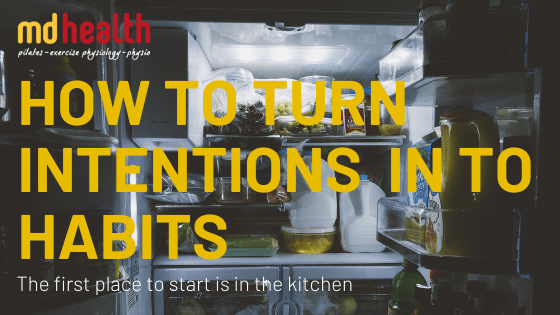The right kitchen
To ensure the best chance of success, creating an environment conductive to change is important – you need to start with the right kitchen. The first place to start when working on changing your health intentions and turning them in to habits is in the kitchen.
This article is a summary on our nutrition information session held on Saturday October 12th. Here we’ll give you the tips and tools you need to succeed in clearing out your fridge and pantry and removing hidden calories and replacing processed foods with nutritious wholefoods.
These are the first steps:
Purge the refrigerator
Look inside and see how many Nutritious Meals you can prepare from the contents. If the answer is 3 or less, its time for a clean out. You don’t need:
- Processed meats
- Kilojoule filled dressings (most contain sugar as one of the top ingredients turning your salad in to something much healthier than you may have intended)
- Sauces and condiments (such as Sour cream, mayonnaise, tomato sauce, peanut butter – these are high in fat and can easily be overindulged)
- Soft drinks and juices (sugar, sugar, sugar! So many empty calories can be consumed from simply drinking them)
- Ice cream and frozen desserts
Pillage the Pantry
It’s time to remove:
- Crackers and cookies
- Chips
- Breakfast cereals
- Cakes
- All other high fat/high sugar treats
Replace
Once you’ve removed the unhealthy contents of your pantry and fridge it’s time to replace the contents of both to be able to make healthy meals, which will include:
- Lean Meats (<10% fat) and poultry
- Cold-water fish (Fresh and Canned)
- Low-fat dairy (cottage cheese, yogurt and milk)
- Whole eggs and fresh egg whites
- At least 3 types of green veggies
- At least 1 type of cruciferous vegetable (vegetables of the family Brassicaceae such as cauliflower, cabbage, kale, garden cress, bok choy, broccoli, Brussels sprouts and similar green leaf vegetables)
- Fruits (fresh and frozen)
- At least 3 types of legumes (e.g. black beans, kidney beans, lentils, chickpeas etc)
- Sweet potatoes and pumpkin
- Grains (oats, brown rice and quinoa)
- Flax-seed oil and Extra Virgin Olive Oil
- Flaxseeds
Tools of the trade
There are a few items that will make your process easier:
- Containers to store food – at least 6 meal size containers. Plus, your home will need a few larger ones for your shop-n-chop and pre-cooked foods
- 2 x Chopping boards – A wood and a plastic chopping board. The wooden board for prepping fruits, vegetables, breads and herbs. The plastic board for preparing raw proteins (meat, chicken, fish)
- Metric cups – Invaluable for estimating food portion sizes, particularly to ensure you are eating enough vegetables (usually at least 1-2 cups)
- The Magic Bullet or Other fast blender – Great for preparing liquid meals of nutritious quality
- Nutrition Scales – It is important to know how much protein you need to consume per meals, so this needs to be measured
- Slow Cooker – Excellent for preparing great stews, soups and casseroles. Just throw the right ingredients in in the morning and ready for dinner
Action steps to take:
- Conquer the supermarket – Be prepared and know what you need to buy, so that you have the ingredients you need for nutritious meals and not just what’s there.
- Buy the best quality proteins, with less than 10% fat – Read the labels and buy the quality cuts that will work towards your nutritious meals
- Do a veggie shop and chop – You will need lots of vegetable, so when you get home, chop them all up and put them in the large containers so that they are ready to use when you need them. In addition, the prepared chopped vegetables are great as part of meals at work or for fast preparation
- Don’t cook for one – If you are making a meals, you may as well make enough for a few meals ( 2-3 at least), so that the effort is worth it and you have meals ready for later
Want to know more?
If you want more information on nutrition and clinical exercise at MD Health or would like to book for a FREE full body assessment with one of our Physiotherapists or Exercise Physiologists, call us on 9857 0644 or email us at admin@mdhealth.com.au



